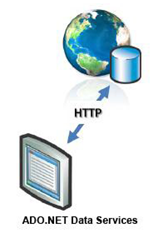ADO.NET Data Services – what waits for us in the future
 Approximately hardly there is more than year back we have seen a new services platform - ADO.NET Data Services. Its occurrence has marked the beginning of wide use of the REST-approach by many developers. At that time this platform was represented as the convenient tool for access to data through HTTP.
Approximately hardly there is more than year back we have seen a new services platform - ADO.NET Data Services. Its occurrence has marked the beginning of wide use of the REST-approach by many developers. At that time this platform was represented as the convenient tool for access to data through HTTP.
Lately it is possible to understand, that this tool is really successful - huge number of developers have started to use immediately it in the projects. The reason for it is quite logical - use of ADO.NET Data Services allows to cut down expenses on realisation of the most typical scenarios at work with services. It does not mean that SOAP-services and WCF have left in the past, however, in scenarios of the data access preference began to give to ADO.NET Data Services.
In spite of the fact that this platform had some defects at work in non-standard situations, its realisation was enough successful. Therefore among developers there could be a wrong impression that development of ADO.NET Data Services has stopped. It is wrong. Here I will tell that we should see in new versions of this product.
As is known in RTM status now is ADO.NET Data Services 1.0. Subsequently in plans there is a release of version 1.5 which will be a part of .NET 4.0 and Visual Studio 2010. At present version 1.5 is in CTP2 state.
That is interesting, the further direction of development of the project got out proceeding from comments which went from developers community. Thus, version 1.5 will be focused on closer integration with WPF/Silverlight applications, will expand possibilities on executing of server queries and will allow to use even more conveniently services at the client side.
New possibilities of ADO.NET Data Services 1.5 it is much more and we will discuss them with you in the near future. And now I wish to make the small review of that we should see in the new version.
- One of weak places of ADO.NET Data Services at present is that in some scenarios we are compelled to load superfluous quantity of data on the client. For example, if the entity contains 40 fields at the access to a corresponding collection we are compelled to load 40 fields all these. At present for such situations it is offered to split entity into smaller and to work with them separately, and for the main query to generate representation with association. However, all it creates additional problems by working out. Other even more unpleasant problem is in case of need to receive quantity of objects in a collection we are compelled to load all collection entirely and already on the client to consider quantity of objects. In new version of ADO.NET Data Services the special attention is paid to these problems. Now we can query projections of any data, and not just entirely all entity. There was a new operator $count which will allow to receive quantity of entities in a collection.
- As for an application programming even more often use platforms WPF and Silverlight in new version ADO.NET Data Services the special attention is paid to data binding. This mechanism is successfully enough applied in WPF/Silverlight projects and declarative binding with data became already habitual approach to working out. In the new version all entities which are generated on the client will implement INotifyPropertyChanged interface, thanks to what begins possible to carry out declarative binding with service data.
- Also in the new version of a considered platform the attention is paid to work with binary large objects (BLOB), for example, with images. Also fields will be allocated in a special way in metadata and to be loaded on the client side only if necessary.
- Interaction with other platforms. In spite of the fact that services ADO.NET Data Services are based on open standards, for work with these services, for example, from Java it is necessary to parse answers from service and to generate queries manually. For simplification of this problem within version 1.5 the mechanism of change of appearance of the answer is implemented (feed customization). Besides, client libraries for work with services ADO.NET Data Services, for example, PHP Toolkit for ADO.NET Data Services which we certainly also will consider already have started to appear.
Thus, the general tendencies and directions are visible to where project ADO.NET Data Services moves and that we should expect from it in the near future.
In the near future we will talk in more details about each of possibilities of ADO.NET Data Services v.1.5, and now I wish to wish you successes in construction of your distributed applications!